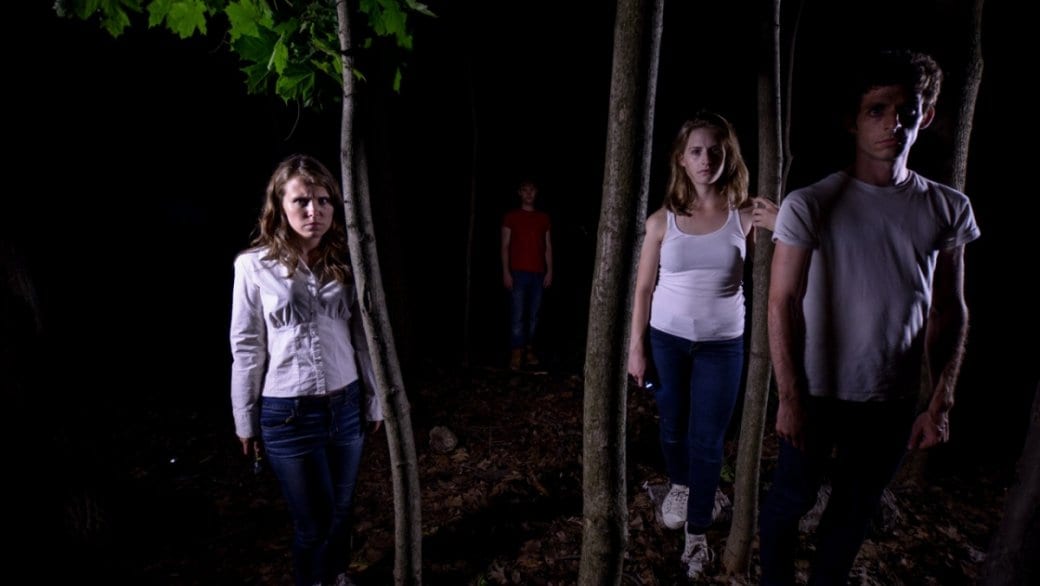Starting out as an artist is never easy. Emerging from school and full of ambition and education, newcomers to the profession are quickly greeted with the reality that there are limited mentorship and development opportunities for emerging creators. Even though they are increasing slowly, for most folks, the fastest path to a career is to just do it yourself.
It’s the approach favoured by Curtis te Brinke and Sadie Epstein-Fine. The pair, along with a collection of their recent theatre school pals, are embarking on the adventure of self-producing with Tire Swing, debuting at Kensington Hall in Toronto on Oct 18, 2016.
The show itself serves as a transition from school to the professional world. Te Brinke began developing it while still at York University under the tutelage of professor Judith Rudakoff (who also worked on queer provocateur Nina Arsenault’s early shows).
Tire Swing is a small-town queer coming-of-age horror story centring on three kids involved in the disappearance of one of their friends, years earlier.
Te Brinke grew up in Clinton, Ontario, (which serves as the official, though unnamed, setting for the play) but the inspiration came to him in nearby Blyth. While waiting for his mother to pick him up one day, he studied a group of kids walking by.
“My brain immediately started to wonder what would happen if one of them were to disappear, and the kind of rifts that would create with the others,” he says “For me the most frightening part was all the unanswerable questions and that became the centre of the piece.”
Epstein-Fine (who’s the daughter of playwright Lois Fine) was in the same class as te Brinke, and watched the script grow from a few monologues to the work they are now preparing to stage. But aside from the satisfaction of seeing it through its phases of development, the story also has personal resonance for her.
“They have to grow up, go through puberty, become teenagers, all in the shadow of this awful thing that happened to them,” she says. “I am a big fan of coming-of-age stories, because I think that moment between childhood and adulthood is super fascinating.”
Aside from its entertainment value, the show is a critical moment in te Brinke and Epstein-Fine’s creative development. Many young artists have gone the self-producing route, with dreams of sold-out crowds, fawning critics and artistic directors forking over cash for their next show.
And while that can happen, the reality is more likely to be empty houses, mediocre media attention (if any, at all), and generally being ignored by those positioned to help them the most. It’s a sad reality for new artists that very few people are interested in what they have to say.
But together, the pair seem reasonably grounded about the road that lies ahead.
“Being an emerging artist is very daunting, but I think it’s a matter of perspective,” te Brinke says. “Do I expect to see my work advertised on streetcars any time soon? No. But I’m happy making it right now.”
“There’s a lot of competition for everything, but as a creator/producer I feel a little better at night knowing I’m calling my own shots more than some people are,” he continues. “I have to keep reminding myself to be patient and keep working.”
Epstein-Fine shares a similar viewpoint. “Sometimes I love being at the beginning of my career, and feeling like I have so much to learn,” she says. “Other times it feels scary and I wish I didn’t love theatre as much as I do . . . I really believe that I do have something to say as an artist and that’s what keeps driving me forward.”
While young queer artists may lack support from the media or their more established counterparts, audiences can make all the difference, they say, especially when older queer generations take a chance on their work.
“I’ve noticed older queer audience come out in droves for established acts, but have no idea who’s doing what in the under-30 group,” te Brinke says. “I’d like to challenge this older group to see some of the young queers moving and shaking right now. As queer artists we’re not only looking to share our stories — we’d love to hear how an older generation of queers responds. I’m fairly certain we’d have a lot to talk about.”
“This story isn’t new, and it’s not specific to our generation,” Epstein-Fine says. “It looks at the how dark things can manifest in small towns and how people will collectively refuse to talk about it. It deals with the very real homophobia that is still present in these places.”
Tire Swing
Oct 18–22, 2016, 7:30pm
Kensington Hall, 56 Kensington Ave, Toronto
To purchase tickets, click here.


 Why you can trust Xtra
Why you can trust Xtra


